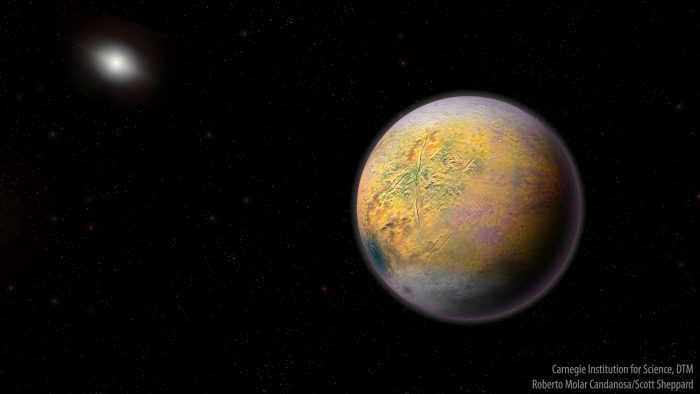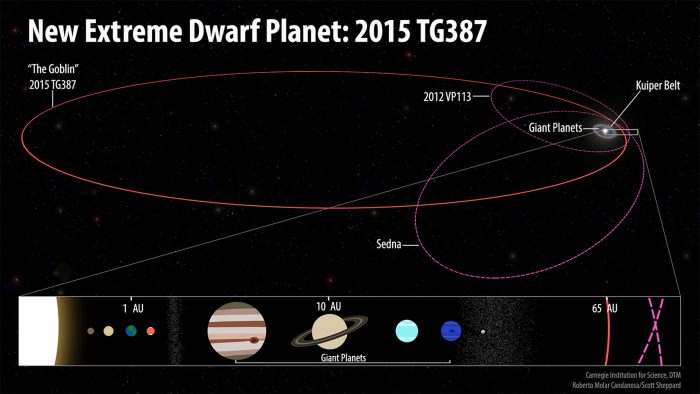What's that? Our headline is too scary? Halloween is still almost a month away, you say?
Fear not, reader. We're not talking about real goblins or monsters. We're talking about objects in our solar system. In this case, 'The Goblin' is actually a dwarf planet called 2015 TG387 (its nickname comes from the fact that its letter/number title begins with the initials "TG").
On its own, The Goblin is a pretty interesting specimen. Let's take a peek.
Let's hear it for the little guys

As we mentioned, it is a dwarf planet. That's it in the photo above—look for the object near the centre moving back and forth. (This gif is toggling back and forth between two photos taken three hours apart, which is how The Goblin was first discovered by researchers at the Carnegie Institution for Science in Washington, D.C.)
Currently, our solar system has several other dwarf planets, including: Pluto (once the ninth planet), Ceres (found in our asteroid belt), Eris, Makemake, and Haumea. Dwarf planets aren't moons, and orbit the Sun, just like the planets. But they haven't "cleared their neighbourhood" of other objects—a fun way of say that they share their general orbit with other similar objects. And speaking of that orbit...
From way out to way way way out
The Goblin has an elliptical orbit, which means that it's not the same distance from the Sun at every point in its orbit. Now, in truth, most orbits are at least a little elliptical. Earth's own orbit is around 152 million kilometers from the Sun at its farthest point, and 147 million km at its nearest. But that minor variation has nothing on the Goblin.
At its closest point, it is about 65 astronomical units, or AU, away. (One AU equals about 150 million km, or essentially the average distance of the Earth to the Sun.) If that sounds far, the farthest point of its orbit is 2,300 AU! Indeed, one orbit of the Sun by The Goblin takes about 40,000 years.
(All of which makes this a lucky discovery. Right now, The Goblin is about as close to Earth as it gets, making it easier to see.)
What an odd way to travel. Why is The Goblin so interested in deep space, anyway? Well, scientists have a theory about that.
Is there a ninth planet after all?

An illustration of the possible Planet Nine, complete with our Sun in the distance. (Roberto Molar Candanosa and Scott Sheppard, courtesy of Carnegie Institution for Science)
Many scientists believe that there are actually nine planets in our solar system. These people think that there is a massive, undiscovered ninth planet in the far reaches of our solar system. Why?
Since around 2014, astronomers were getting confused by the odd elliptical orbits of newly discovered distant objects, such as another dwarf planet called Sedna. Like The Goblin, these objects went in relatively close to the Sun before coming way back out. Something must be influencing their orbits, scientists thought. Something big.
Their conclusion? A large mystery planet, probably about ten times the size of Earth and around 600 AU from the Sun. This is our 'monster'. Will The Goblin bring us closer to discovering its position? Does it even exist at all? Do we even dare find out?
Happy early Halloween, everybody!
 Meet 2015 TG387, or The Goblin. What's with that weird orbit? What's a 'Sedna'? We'll get to all of it, we promise! (Roberto Molar Candanosa and Scott Sheppard, courtesy of Carnegie Institution for Science)
Meet 2015 TG387, or The Goblin. What's with that weird orbit? What's a 'Sedna'? We'll get to all of it, we promise! (Roberto Molar Candanosa and Scott Sheppard, courtesy of Carnegie Institution for Science)









